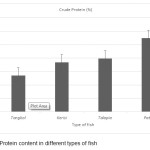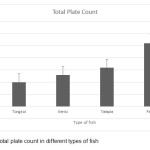Introduction
Pekasam is one of the ancient foods that originated from Malaysia (Awang, 2001). Pekasam is described as a fermented product which is produced by mixing fresh fish with salts, tamarind and roasted rice (Steinkraus and Reilly, 1993). Pekasam, a local traditional fermented fish, is very popular among people in Kedah, Perak and Kelantan, which is an example of many different types of fermented food products in Malaysia. The minimum percentage of salt used is not less than 10% (Syahputra et al., 2012). Subsequently, it is allowed to ferment for a minimum of two weeks and can reach up to one month. Acting as an appetizer, pekasam fish is usually fried and garnished with fried slices of shallot and red chilies, prior to consumption with rice. Besides containing high amounts of proteins, the edible bones contain minerals (Venugopal, 2009).
Fermentation is a food processing technique that allows fish to be kept at a longer period of time. In pekasam, the lactic acid fermentation is mainly responsible for the unique flavor of pekasam. The presence of lactic acid produced during the lactic acid fermentation is responsible for the sour taste and for improving the microbiological stability and safety of the food. Lactic acid fermentation also gives tasty flavor to the fermented fish. The sugar in the rice is converted into lactic acid which serves as a preservative. Fermentation also leads to an increase in protein content (El Tinay et al., 1979), enhancement of carbohydrate accessibility (Elkhalifa et al., 2004) and improvement in amino acid balance (Au and Flies, 1981). At the household fermentation process, the selection of the fish depends on the availability and cost. However, the taste, color and shelf life of pekasam will be varied. It is critical to determine the suitability of fish for pekasam production, but information on selecting the best type of fish is scarce. With the information, it will be beneficial for pekasam producers to choose the right fish type for the purpose of up scaling the production to industrial capacity. Hence, the objective of the present investigation was to study the effect of protein content on the fermentation process of pekasam.
Materials
Four types of fishes were used. The fish,namely Euthynnus affinistuna or Tongkol, Pristipomoides filamentosus or Kerisi, Tilapia mossambica or Tilapia,and Pangasius pangasius or Patin were weighing between 90 to 105 g and purchased from wet market in Peninsular Malaysia and underwent natural fermentation. The types of fishes were chosen based on two groups which were sea water fishes (Tongkol and Kerisi) and fresh water fishes (Talapia and Patin).
Methods
Determination of crude protein
Protein analysis was carried out before the fermentation process was conducted. Fifteen g of fish meat were taken from each type of fish. Each sample was ground and homogenized before advancing to the next phase. The protein analysis was carried out by using standard Kjedahl method (AOAC, 2000). Analysis was carried in triplicates.
Fermentation process
Natural fermentation was carried out by mixing each sample with ground sautéed rice and salt. Each type of fish was scaled and weighted for 300 grams. The fish were cut and cleaned thoroughly. The weighted and cleaned fish were tossed and dried with kitchen towel to prevent extra moisture inside the fish. An amount of 100.0 g of ground sautéed rice and 20.0 g of salt were coated onto the fish. The process was conducted in an aseptic and hygienic practices. Then, it was sealed in a container and stored inside a dark room at ambient temperature (28-30 °C) for 30 d. After the incubation period, each sample was withdrawn for microbial analysis.
Total plate count (TPC)
The method was carried out according to the International Organization for Standardization (ISO) 4833:2003 (E). From the serial dilutions, 1.0 mL of the serial dilutions was transferred into triplicate Petri dishes by using a sterile pipette. Only dishes with colonies in the range of 30-300 were selected and perceived statistically significant. The result was shown in colony forming units (cfu/mL). Analysis was carried out in triplicates.
Results and Discussion
Figure 1 shows the protein content of selected fish being used in this experiment. Patin fish was found to be highest in protein content (27.5%) followed by Tilapia (19.9%), Kerisi (18.9%) and Tongkol (13.5%). Microorganisms differ in their ability to use nitrogenous compounds as a source of nitrogen for growth. Some of the lactic acid bacteria grow best with polypeptides as nitrogen food. The presence of fermentable carbohydrate as substrate was mainly from ground sautéed rice, resulting in acid fermentation and suppression of proteolytic bacteria, which is termed as ‘sparing’ action on the nitrogen compounds. In addition, the production of obnoxious nitrogenous products is prevented (Frazier et al., 2012).
The microbial analysis was carried out by using MRS agar to isolate the amount of Lactobacillus spp. present inside each sample. Figure 2 shows the number of Lactobacillus spp. in the pekasam samples. The numbers of Lactobacillus spp. were converted to log CFU/ml based on manual suggested by Aneja (2003). The result showed that Patin has the highest number of Lactobacillus spp. (6.21 log CFU/mL) followed by Tilapia (6.11 log CFU/mL), Kerisi (6.08 log CFU/mL) and Tongkol (6.05 logCFU/mL).
During fermentation process, many lactic acid producing bacterias grow and produce organic acids, in particular lactic acid, which lowers the pH and preserves the product (Fernandez, 2006). The presence of acid also contributed to the flavor of the product. The formation of acid, together with the presence of salt, prevented the growth of putrefactive bacteria. The addition of roasted ground rice on the fish acted as a source of carbohydrate to support the growth of Lactobacillus spp. Color and flavor also developed during the fermentation process. In addition, fish protein was broken down to peptides and amines by autolysis. Autolysis produces profound structural changes in muscle that bring about a difference in mouthfeel and altered the texture (Steinkraus and Reilly, 1993). These compounds, together with the acids and other products from microbial fermentation, increased the distinguished flavor and odor of the pekasam. Lactobacilli spp. has important characteristics in food, such as their ability to ferment sugars with the production of considerable amount of lactic acid, making it possible to use them in the production of fermented products (Frazier et al., 2012). Patin fish has high protein content which allows considerable growth and acid production by lactic acid bacteria in the processing of pekasam. The small amount of acid produced by lactic acid bacteria during the early part of fermentation resulted in decreased pH value. This enabled the lactic acid to suppress the undesirable hydrolyzing and proteolytic competing organism. It is known that peptidases catalyze the hydrolysis of polypeptides to simpler peptides which are finally converted to amino acids (Frazier et al., 2012). The latter give flavors that are desirable to the fermented products.
The study shows that protein content in fish plays an important role during the production of pekasam. The increment of the Lactobacillus spp. is dependent on the protein content of the fish. It can be suggested that the increment of Lactobacillus spp. is associated with higher protein content in fish during the fermentation process. Formation of acid, together with the presence of salt, helps to avoid the growth of putrefactive bacteria in the final product. Patin fish is known as a famous freshwater fish which is suitably used as a fermented product. Lactic acid fermentation facilitated in masking of the fishy odor and enhanced the color characteristic of the product that makes it more flavorful, appealing and have longer shelf life. These results suggest the need of further studies about the importance of protein content during the fermentation process.
 |
Figure 1: Protein content in different types of fish Click here to View figure |
 |
Figure 2: Total plate count in different types of fish Click here to View figure |
Acknowledgements
The authors are grateful to Assoc. Prof. Dr. Nor Ainy Mahyudin, Faculty of Food Science and Technology, Universiti of Putra Malaysia for the support in the form of infrastructural facilities made available for undertaking the present study.
References
- Adams, M. R., and Moss, M. O. (2008). Fermented and Microbial Food. In Food Microbiology (pp. 347-348). Royal Society of Chemistry.
- Aneja, K. R. (2003). Microscopic Examination of Living Things. In Experiments in Microbiology, Plant Pathology and Biotechnology (p. 81). New Age International
- Au. P. M. and Fields M. L., (1981) Nutritive quality of fermented sorghum. J. Food Sci. 46, 652-654.
CrossRef - AOAC, 2000. Association of Official Analytical Chemists. 17th Ed., Official Method of Analysis,Washington D.C., USA.
- Awang, C. R. (2001). Processing Technology for Fermented Tilapia. Retrieved 16 June, 2013, from Agromedia MARDI: http://agromedia.mardi.gov.my/magritech/tech_detail_fdscience.php?id=369
- Department Of Fisheries Malaysia. (2011). Retrieved Thursday December, 2013, from Department Of Fisheries Malaysia: http://www.dof.gov.my/en/fermented-fish1
- El Tinay A. H., Abdel Gadir A. M. and El Hidai M., (1979) Sorghum fermented kisra bread I. Nutritive value of kisra. J. Sci. Food Agric. 30 859-863
CrossRef - Elkhalifa A. E. O., Schiffler B. and Bernhard R., (2004) Effect of fermentation on the starch digestibility, resistant starch and some physicochemical properties of sorghum Flour. Nahrung/Food. 48, 91 – 94.
CrossRef - Fernandez, M., and Zuniga, M. (2006). Amino acid catabolic pathways of lactic acid bacteria. 155-183.
CrossRef - Hébert, E. M., Raúl, R. R., and Graciela , S. (2004). Evaluation of Minimal Nutritional Requirements. Lactic Acid Bacteria in Functional Foods, 139-148.
- Hui, Y. H., and Evranuz, E. O. (2012). Malaysian Fermented Fish Products. In Handbook of Animal-Based Fermented Food and Beverage Technology, 2nd Edition (pp. 713-715). CRC Press.
CrossRef - Hui, Y. H., Goddik, M. L., Josephsen, J., Nip, W. K., and Stanfield, P. S. (2004). Partially Fermented Tea. In Handbook of Food and Beverage Fermentation Technology (p. 960). CRC Press.
CrossRef - Steinkraus, K. H., and Reilly, P. J. (1993). Pekasam. In Fish Fermentation Technology (pp. 101-102). United Nations University Press.
- William C. F., Dennis C. W., Vanitha K N. (2012) Food as substrate in microorganism. In William C Frazier, Dennis C Westoff, K N Vanitha Food Microbiology, 5th Ed. New York: McGraw-Hill Education
- Venugopal, V. (2009). Marine products for Healthcare: Functional and Bioactive Nutraceutical compounds from the ocean, CRC Press.

This work is licensed under a Creative Commons Attribution-NonCommercial-ShareAlike 4.0 International License.

This work is licensed under a Creative Commons Attribution 4.0 International License.




